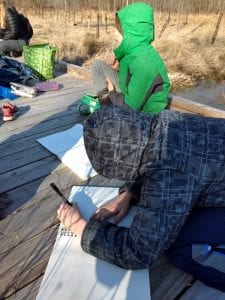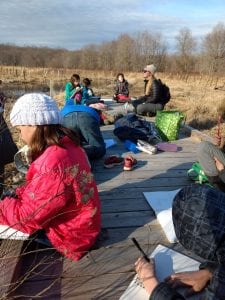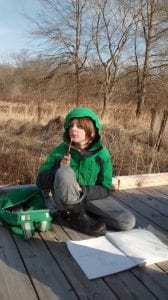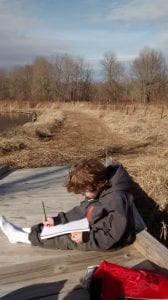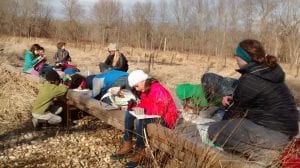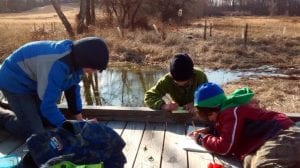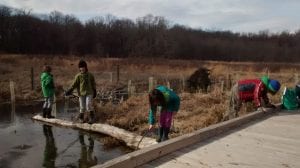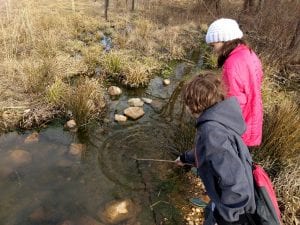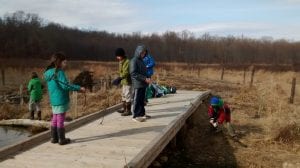2/26/2019
Welcome back to Irvine for our Spring semester of Earth Friends Homechool! This semester we are continuing on the theme we started in Fall, learning about how artists are inspired by the art and science of the land to create land art. Sometimes this land art is small, sometimes it’s on a large, permanent scale, sometimes it’s permanent and other times it’s ephemeral (meaning it will eventually disappear naturally). Artists we will be studying this semester include Andy Goldsworthy, Michael Grab and Richard Shilling. We hope to be inspired by some of these artists to create our own land art here at Irvine. Other studies we will conduct include studying the science of the land by doing water testing, collecting macroinvertebrates to evaluate stream and pond health and learning about geology.
We started our first day of class by going around the picnic table, introducing ourselves and sharing an animal we would like to be. Some of us had some more commonly thought of animals like hawks and wolves while others wanted to be jellyfish and squid, cool! Another fun activity we are doing this Spring is making a class journal, like a yearbook. I introduced the idea of the yearbook by showing a few of the first pages where we will be gluing in a class picture, a map and a list of some of our favorite places. Each of us will get our own two pages in the book too that we can use to share more about ourselves with our classmates. Also in the book we will be adding some of our artwork, places we hike and explore and other cool and interesting discovers.
With that in mind we started our hike to the gazebo where we enjoyed snack and shared some of the fun adventures from over the winter. After a few minutes to climb our favorite tree, we headed into the meadow and down the hill to the Education Hut. Here we gathered and reviewed some of our intentions for our class. These intentions are guild lines, or ways we intend to act in our class. As a group we brainstormed some of our intentions and provided examples, writing them down in our class book. After everyone signed the page, agreeing to them, we started off on our hike.
Walking through the meadow we noticed the red tops starting to show on the maple trees. For the next two weeks we’ll be learning more about maple sugaring, how trees produce sap and the process that is used to make maple syrup. On our way through the Pollinator Meadow, we stopped at one of the ponds at the base of the hill. Quickly we noticed that the pond was full of algae. Algae is an aquatic plant that can sometimes grow into huge blooms. These blooms of algae form mats that can block sunlight from getting to the bottom of the pond preventing other plants from growing. Also, when the algae dies it will begin to decompose and bacteria is the main way that dead plants decompose, however, bacteria use oxygen to survive. When you have large amounts of dead algae and even larger amounts of bacteria, the oxygen is used up from the water, causing dead zones in the water. The dead zone in the Gulf of Mexico near the Mississippi River is a common example of this. The algae we were exploring and investigating is harmless to people and animals and is a food source for animals like tadpoles and ducks. We collected some of the algae in a jar, picked it up with a stick and with our hands. We squeezed it and noticed how much water it can hold and observed what it looked like when the water was removed. Here is a link about algae and how it can cause dead zones: https://www.epa.gov/nutrientpollution/effects-dead-zones-and-harmful-algal-blooms
After some pond investigations we hiked further down the Pollinator Meadow to another pond and stopped on the bridge. We observed that this pond had less algae in it. Once the weather warms up we’ll do some more comparisons among our habitats and spaces here at Irvine. At the bridge in our sit spots (a sit spot is an opportunity for people to sit alone and quietly, observing nature, writing, drawing, reading, etc) we opened our journals and thought about some of our own personal goals for our class. Everyone wrote down at least 2-3 goals that they hope to achieve this Spring. Next week we will have the opportunity to share our goals if we choose. With the sun setting behind the trees and the red-tailed hawks circling over the meadow, we hiked back to Irvine.




